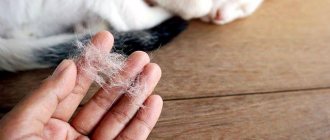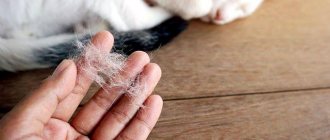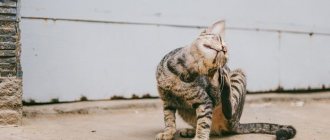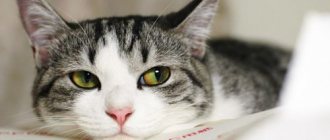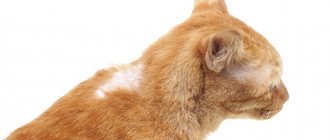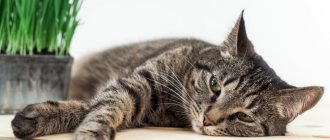We all know how soft cat fur feels under our fingertips and how impeccable their hygiene is. However, as a cat owner, I am accustomed to ailments that most cats have to contend with at least once in their lives. More importantly, I know that some of them may be a sign of a larger problem. So, when I noticed an excessive amount of loose hair around my house, the only question I thought was - why does my cat's hair fall out in clumps?
Some may think that hair loss in cats is quite common. We've all seen how much hair is left on our clothes when a feline leaves our lap after a short cuddle session. However, if the fur is falling out in clumps, it may be a sign that your cat needs to be taken to the vet.
About feline alopecia
Due to stress or some other factors, hair may begin to fall out in clumps, leaving a receding hairline all over.
The same thing can happen with cats. Alopecia in cats is a fairly common problem and comes in several forms. It can be partial or complete, and the cat can lose hair symmetrically or in a completely random pattern.
The problem is that hair loss in cats can be caused by almost anything. Some triggers require careful testing, especially since some cats may be born with it.
© shutterstock
Manifestations and symptoms
To understand the cause of baldness, it is necessary to establish with what intensity this phenomenon is progressing and what accompanying symptoms appear in the animal.
The main signs are:
- uniform thinning of coat throughout the body;
- bald spots on the stomach, face, paws, ears, at the base of the tail or throughout the tail;
- redness and peeling of the affected areas;
- itching;
- signs of anxiety (constant licking of sore areas, nervous tail wagging, etc.);
- ulcers, ulcers, bumps or blisters on bald spots.
Recognizing these symptoms requires immediate attention to your veterinarian, as hair loss can quickly worsen.
Fleas
Owning a dog and a cat, or living in an area where the cat has easy access to the outdoors, may be the reason your feline suddenly loses its fur in clumps. If a cat is able to go outside and socialize in nature or is in close contact with a dog every day, he may be bitten by a flea.
Now the cat can avoid losing hair because of the fleas themselves. The cause of baldness in this case is an allergy to flea bites. If a feline is sensitive to flea saliva, it may develop alopecia, especially in the hindquarters.
Unfortunately, it only takes one flea to cause a rather unpleasant and sometimes long-lasting reaction. This is why it is important to take your cat to the vet immediately to avoid further damage to the skin and fur.
Luckily, this condition is easy to treat with some flea treatments and shampoo. If the itching persists and hair loss is excessive, your veterinarian may also prescribe antihistamines or corticosteroids.
How to understand that this is a normal shedding
If the cat is cheerful and active, and its fur is smooth and shiny, but remains in clumps on furniture and other surfaces, most likely this is normal shedding. Shedding is a completely natural period in a cat's life. In an adult animal, it lasts from several weeks to two months, but the first molt can last for a whole year.
You can tell that a cat is shedding normally by the following signs:
- wet nose;
- ears and paw pads are warm, but not hot;
- appetite is not impaired;
- the cat does not itch or chew its fur;
- Bald spots do not form on the animal's body.
Shedding is a natural process in cats
Adult cats that live outdoors usually shed twice a year, in spring and fall. Cats that do not leave the apartment all year round practically do not feel the change of seasons, so molting may become blurred for them. Increased dryness of the air, especially if the cat likes to lie on hot radiators in winter, can prolong the molting process up to three months, so you need to humidify the room.
At the age of 5-8 months, the kitten begins to change from baby fluff to adult fur, and the color may noticeably change. At this time, the baby especially needs care and healthy nutrition.
Of all the cat breeds, only completely hairless Sphynxes never shed. In other cases, molting occurs one way or another. Cats with a dense undercoat shed more often and more intensely - British, Siberian, Persian and Maine Coons. Fluffy cats, for example, Burmese, Angora, Somali, have less dense undercoat, although they grow large collars by winter. Bengal, Siamese, Abyssinian, and Singaporean breeds shed moderately - they have almost no undercoat. In the usual sense, cats of such breeds as Devon Rex, Cornish Rex and La Perm, as well as overgrown Sphynxes, do not shed. Only a few times during their lives they shed, up to the formation of bald spots, changing their fur completely. However, some of them are prone to traditional seasonal molting.
Ticks
However, it's not just fleas that cat owners have to worry about. Mites are common on most mammals and when their populations increase dramatically, they can cause severe itching, skin lesions, and hair loss in clumps, among other things.
Mite infestations usually occur when a cat's immune system is not functioning properly. Because of this, it is not uncommon for stressed cats or felines to already have some other disease. Additionally, if hormone levels rise or the cat begins to produce excess oil, a common consequence is an outbreak of Demodex mites, and the end result is a condition called mange.
In most cases, mite infestations are evident around the cat's eyelids, flanks, head and neck. In addition to missing hairballs, his skin will also be scaly, with lesions and scabs.
To confirm the presence and determine the type of mite causing the problem, the veterinarian will scrape the skin. Sometimes hair analysis can also help in identification. You may also need to do a urine test to rule out other conditions with similar symptoms.
The good news is that in 90% of cases, demodectic scabies goes away on its own with time. However, if it is severe, long-term medications and lime-sulfur sauces may be needed to control the condition and help the cat recover.
Diagnostics
Since there are many causes of feline alopecia, only a veterinarian can make an accurate diagnosis. Diagnostics involves a number of procedures:
initial examination of the animal. The specialist evaluates the external condition of the cat’s coat and different areas of the cat’s body; recording complaints about the cat's condition
The veterinarian takes into account information from the animal owner about the life of the pet, its diet, etc.; laboratory examination of hairs. This is done using a microscope
There may be parasites on the hairs that are not visible without special equipment; blood analysis. In most cases, a general examination is required, but sometimes a specialist will refer you to a biochemical examination. scraping It is taken from lesions on the epidermis.
Only a veterinarian can carry out the necessary diagnostics and prescribe the correct treatment.
Fungal infection (ringworm)
Although there is a “worm” in this disease, it is actually a fungal infection that can be easily transmitted to people. Cats usually become ill from contact with other infected animals. From there, the infection spreads and can wreak havoc on your home, whether you have a cat or a kitten.
Hair loss in clumps is the most common symptom. A ringworm infection causes the hair to become quite brittle so it breaks, leaving behind clumps. The areas most commonly affected are around the feet, ears and face.
The skin will also show signs of infection; The ears, feet and parts of the face may appear slightly reddish, and there may also be white or gray crusts. In general, hairless skin will appear dry and flaky.
Looking for an answer to the question, why does my cat's fur fall out in clumps? this infection seemed like the biggest red flag to me. Since my cat was leaving clumps of fur behind her and some of the hairless parts were quite dry to the touch, I had to confirm the diagnosis with a vet.
Fortunately, the cat recovered quickly. To confirm the infection, the veterinarian tested a fungal skin culture. Treatment included the use of various antifungal agents such as shampoos, sprays and creams. Treatment may also include oral medications, but they were not necessary in our case.
What to do if your cat's hair falls out in clumps to the point of bald patches
First of all, it is necessary to analyze the causes of hair loss: change of food, contact with an animal carrier of the infection, stress, and perhaps the time of seasonal molting.
If a cat develops itching, hair falls out in clumps, scratches its skin into wounds, refuses to eat, becomes lethargic or aggressive, it is necessary to immediately contact a veterinary clinic.
If your cat is experiencing excessive hair loss, you should contact your veterinarian.
Allergies
If a cat is allergic to dust or pollen, something in her food, or certain medications, her body will begin to itch, causing her to groom herself excessively to soothe herself. This can cause the fur to fall out in clumps as the cat licks the fur until a bald patch remains.
Common allergens include beef, dairy and fish. To make sure your cat food is no longer suitable, you can try switching to other brands for a while. Additionally, environmental allergies, such as mold spores and grass, can also cause atopic dermatitis to:
- Armpits
- Wrists and ankles
- Groin
- Around the eyes and between the toes
- Around the muzzle and ears
To confirm an allergy, the veterinarian will examine the cat and its entire medical history. Sometimes a serological allergy test and intradermal testing can help determine the cause.
However, treatment depends on the allergen and sensitivity level. If your cat is hypersensitive, desensitizing therapy may help. On the other hand, to relieve itching, your veterinarian may prescribe anti-itch sprays, antihistamines and corticosteroids, as well as cyclosporine (for long-term allergies).
Treatment of hair loss in cats
Hair loss in cats can be eliminated with the help of comprehensive measures - drug treatment, adjustments to living conditions and diet. To determine the cause of your cat's hair loss, you need to consult a veterinarian. He will prescribe the appropriate treatment.
Hair loss treatment is carried out comprehensively
Medicines
The first step to a beautiful and fluffy coat is removing parasites. First, an insecticidal treatment is carried out to destroy lice, fleas, and ticks. For this purpose, drops are purchased at the veterinary pharmacy. They should be used strictly according to the instructions, without exceeding the dosage. If there are a large number of fleas, the treatment is repeated after 7-10 days.
Dichlorvos and other chemicals not intended for cats are strictly prohibited. The use of medicinal products for humans is also prohibited. Even safe paracetamol can cause serious complications in a cat.
3-7 days after the procedure for treating external parasites, a drug is given to remove helminths. The tablet should be given in the morning, with food. The dose is calculated according to the cat's weight.
Sedatives are used to reduce stress levels. Antibacterial and antifungal drugs are used to combat bacterial and fungal infections. For the proper functioning of immune cells - immunostimulants.
All medications, dosage and course of therapy are determined by a veterinarian depending on the cause that caused hair loss.
Give your pet only the medications intended for it.
The use of medicated shampoos and special preparations
In addition to taking medications, antiseborrheic shampoos, ointments and antiseptics are prescribed to treat suppurations.
Medicated shampoos are mainly designed to combat parasites. They contain not only a substance that can get rid of parasites, but also relieve itching and irritation in the cat. Flea shampoo for pets will also help heal small wounds and scratches on his body. Special flea shampoos have been created for kittens, consisting of herbal extracts, vitamins and essential oils.
Anti-dandruff shampoos for cats are designed for animals with problem skin. Its composition, like the anti-lichen shampoo, includes antifungal drugs and special components that will eliminate dandruff, flaking and crusts that appear due to seborrhea.
Anti-allergenic shampoo is intended for cats suffering from frequent manifestations of allergies on the skin. This shampoo contains no allergy-causing ingredients and also prevents irritation from dandruff or any external irritants.
Diet for hair loss
For effective hair growth and healthy skin, your cat needs a large amount of protein. About 30% of daily protein intake is used by the animal's body to renew and form skin cells. Not getting enough high-quality protein in your diet or consuming protein that is poorly absorbed can lead to brittle, thinning hair and hair loss.
With a natural diet, the basis of the diet for 4-5 months will be: lean meat (pork is excluded), lean sea fish, semi-cooked without bones, lungs, heart, liver, stomach and other offal, kefir, low-fat sour cream, small quantities of vegetables, steamed cereals boiling water or broth.
When feeding commercial dry and wet food, it is necessary to choose a high-quality product intended for allergy sufferers.
Vitamins A and E are also very important for maintaining a healthy cat's coat and preventing excess shedding. They regulate cell growth and act as natural antioxidants. A lack of these vitamins can lead to disruption of the production of keratin, which is the main component of hair. B vitamins and biotin will help restore fur faster.
For a beautiful coat you need vitamins and a balanced diet.
Psychogenic alopecia
Another form of alopecia that many cat owners don't consider at first is psychogenic alopecia, which causes the cat to pull out and chew its own hair due to anxiety, stress or fear. However, since cats like their daily routine and do not adapt to new people and environments easily, this form of alopecia is quite common.
The main problem here is the cat's behavior because she uses grooming as a way to relax. When it is exposed to too much stress, it can develop into over-grooming, causing the cat to lick fur until it becomes hairless.
The best way to manage this form of alopecia is to take better care of your cat. It is extremely important not to put too much (unnecessary) stress on her and to maintain a consistent daily routine. However, in more severe cases, anti-anxiety medications can also be used.
© shutterstock
Oncological diseases
Cancer tumors cause many negative processes in a living organism. The tumor grows rapidly, robbing the body of nutrients, blocking the blood flow at its location, disrupting the functioning of the body, so hair loss is a fairly common symptom of oncology. The most dangerous pathology in which a cat goes bald is skin cancer. You can suspect your pet has a terrible disease based on the following symptoms:
- enlarged lymph nodes;
- sudden weight loss;
- strongly noticeable unpleasant odor from the mouth;
- purulent discharge from any part of the body;
- loss of appetite;
- dyspnea;
- non-healing wounds or ulcers.
Hormonal imbalance
Now, when looking for an answer to the question of why is my cat losing hair in clumps, don't be surprised if you see hyperthyroidism on the list of common causes. When a cat suffers from overproduction of T4, its coat will often appear unkempt and greasy, with small bald patches here and there.
This is just one symptom of an overactive thyroid. To diagnose the disease, a veterinarian must not only check hormone levels, but also rule out kidney failure and diabetes. Both of these conditions have common symptoms.
On the other hand, a cat may be suffering from a hormonal imbalance unrelated to its thyroid gland. Its steroid levels can be high, causing hair follicles to die, often symmetrically. One of the most common causes of this is Cushing's disease, a metabolic disorder that can be quite difficult to diagnose. It shares many of the same symptoms as diabetes, but can also lead to hair loss and thin, fragile skin.
In both cases, medications and surgery are possible. If it is hyperthyroidism, the cat may also be given radioactive iodine therapy.
Prevention
A cat's tooth fell out: main symptoms and treatment options
To prevent a cat from developing a bald spot on its head, there are a number of preventive measures. The pet is periodically examined, regularly given prophylaxis against worms, and a balanced diet is selected. The animal is promptly vaccinated against diseases. Your pet should not be walked near places where stray cats accumulate.
Attention! Long-haired cats need to be brushed frequently. It is necessary to monitor the cleanliness of the fur of all cat species.
Diet
You need to put your cat on a diet diet. Do not feed your animal dry food, as industrial food contains a large amount of preservatives and artificial flavors.
It is recommended to feed your pet boiled dietary meat - veal, rabbit, turkey. You can add seasonal vegetables and fruits to your diet.
If a pregnant cat has a bald spot on her ear, the reason is a lack of vitamins, which she does not receive from food. Such pets need special nutrition rich in nutrients.
Important! It is forbidden to feed the cat sweets, smoked meats, and salty foods. Such products are strong allergens
Protect from stress
A nervous situation in the house, the appearance of children or other animals - all these factors adversely affect the cat’s psyche and can cause bald spots in a cat.
If a cat reacts painfully to changes in his life schedule, the arrival of guests, or a change of environment, you need to try to protect him from stress. You can treat your pet’s nerve pain with sedatives, which should be prescribed by a veterinarian.
Poor nutrition
Finally, poor diet may be the problem. Today's commercial pet food is full of fillers that "bulk" the final product but have virtually no nutritional value. Because of this, a cat's fur often suffers when it eats low-quality food. The cat is not getting enough nutrients to support it!
However, as bad as it may sound, hair loss in clumps is reversible. You will have to switch to a healthier brand of cat food. The fewer fillers, the better; in any case, they do nothing for the cat's health and may reduce its quality of life. You may also consider adding powdered vitamins to your food to boost its nutritional value.
But in some cases, food may not be to blame either. If an underlying medical condition is preventing your cat from absorbing nutrients, this will need to be addressed by a veterinarian first.
Article by: Michael Grover I have been a pet owner most of my life. Now I'm retired and spend my days writing about problems related to cats and dogs. I am passionate about ending animal cruelty in any form. My passion is helping people like you identify behavioral problems in cats.
Preventive measures
The quality of the coat is an indicator of the health of the cat. If an animal is losing a lot of hair, it is important to notice it promptly and take action. The main measures that the owner can take to keep the cat beautiful and fluffy:
- Selection of a balanced diet. Natural food should contain all the necessary vitamins. Dry and wet food must be of high quality, specially developed in accordance with age, condition (pregnancy, castration, sterilization), concomitant disease - medicinal lines of food.
- Antihelminthic courses. Veterinarians recommend every 3 months.
- Use anti-flea collars or regular treatment with special drops.
- Mandatory vaccination.
- Elimination of foods and items that cause allergies.
- Proper care – regular brushing and grooming.
- Maintaining cleanliness in the room.
Caring for and caring for your cat will keep it healthy for a long time.
For timely detection of hidden pathologies, veterinarians recommend taking tests every year. Elderly and weakened cats with chronic diseases need to visit a veterinary clinic twice a year.
Caring for your pet will help you avoid serious illnesses. Only if you follow all the recommendations, the cat will have a beautiful, thick coat and a healthy appearance.
Establishing diagnosis
Algorithm for making a diagnosis by a veterinarian:
- collecting anamnesis (information about previous diseases, introducing new foods to the diet, recent moves, etc.);
- inspection;
- general blood analysis;
- hair microscopy;
- scraping the skin to identify fungal infections;
- Ultrasound and x-ray as needed.
It is possible to accurately determine the root cause only by excluding already known points. For example, if there are no bites or changes in feeding, an allergy can be ruled out. An examination of the animal is mandatory, during which it is necessary to carefully examine the belly and paws.
It is equally important to establish the condition of the hairs themselves and evaluate the affected area. Bare spots can be either extensive or very small.
If your cat has recently undergone surgery, the hairs at the site of the suture may thin out or stop growing altogether. It often happens that they fall out at the injection sites of medications.


